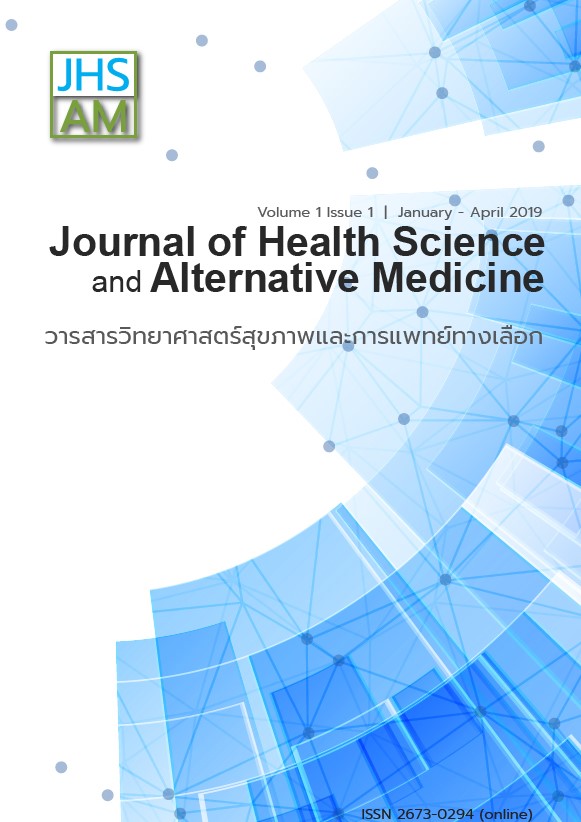Quality of Life Among HIV/AIDs Patients in a Secondary Thailand Border Hospital: A Cross-Sectional Study
Main Article Content
Abstract
Introduction: AIDS (Acquired Immunodeficiency Syndrome) has been long recognized as a major public health threat for humankind. In 2018, there were 36.9 million people living with HIV and 1.8 million people becoming newly infected globally. Purpose: The study aimed to assess the quality of life and determine factors associated with a good quality of life among HIV/AIDS patients in Chiang Sean hospital, Thailand. Methods: A cross-sectional study was conducted. All HIV/AIDS patients who were attending antiretroviral (ARV) clinic at Chiang Sean hospital in 2017 were invited to participate in the study. A questionnaire and WHO quality of life BREF (WHOQOL-BREF) form were used for collecting data. Chi-square test was used to determine the associations between variables. Results: Totally, 246 HIV/AIDS patients enrolled into the study; 53.3% were females, 44.3% were aged 41-50 years, 92.3% hold Thai nationality. The overall quality of life was in a moderate level (96.3%). Nearly two thirds scored moderately in psychological, social relationship and environment domains. No Thai nationality and low CD4 level had statically significant associations with a low quality of life (p-value<0.05). Conclusion: HIV/AIDS patients at Chiang Sean hospital have moderate quality of life. A specific public health intervention should be developed to improve quality of life among the HIV/AIDS patients.
Article Details
JHSAM publishes all articles in full open access, meaning unlimited use and reuse of articles with appropriate credit to the authors.
All our articles are published under a Creative Commons "CC-BY-NC-ND 4.0". License which permits use, distribution and reproduction in any medium,
provided that the original work is properly cited and is used for noncommercial purposes.
References
[2] World Health Organization- Thailand (WHO-Thailand). HIV/AIDS. https://www.searo.who.int/thailand/areas/hivaids/en/
[3] Bureau of AIDS, TB and STIs, Ministry of Public Health. HIV/AIDS in Thailand 2017. https://aidssti.ddc.moph.go.th/contents/view/1650
[4] Chiang Rai Public Health Provincial Office. HIV/AIDS in Chiang Rai 2018. https://www.boe.moph.go.th/aids/Downloads/book/2560/13732_HIV_2560_for%20web.pdf
[5] 5.World Health Organization (WHO). Transition to new antiretrovirals in HIV programs. https://www.who.int/hiv/pub/toolkits/transition-to-new-arv/en/
[6] World Health Organization (WHO). WHOQOL-BREF. https://www.who.int/mental_health/media/en/76.pdf
[7] Cooper V, Clatworthy J, Harding R, Whetham J. Measuring quality of life among people living with HIV: a systematic review of reviews. Health Qua Life Outcomes. 2017; 15(220): DOI: 10.1186/s12955-017-0778-6.
[8] National Health Security Office (NHSO). ARV funding. https://www.nhso.go.th/online/
[9] Apidechkul T, Laingoen O, Suwannaporn S. Inequity in Accessing Health Care Service in Thailand in 2015: A Case Study of the Hill Tribe People in Mae Fah Luang District, Chiang Rai, Thailand. Journal of Health Research. 2016; 30(1): 67-71.
[10] World Health Organization-Thailand (WHO-Thailand). Hill tribe population in Thailand, 2018. https://www.who.int/countries/tha/
[11] Apidechkul T. A 20-year retrospective cohort study of TB infection among the hill tribe HIV/AIDS population in Thailand. BMC Infect Dis. 2016; 16: 72. DOI 10.1186/s12879-016-1407-4
[12] Osei-Yeboah J, Owiredu WK, Norgbe GK, Lokpo SY, Obirikorang C, Allotey EA, et al. Quality of life of people living with HIV/AIDS in the Ho municipality, Ghana: A cross-sectional study. AIDS Research and Treatment. 2017; DOI: 10.1155/2017/6806951
[13] Pozniak A. Quality of life in chronic HIV infection. The Lancet HIV. 2015. DOI: 10.1016/s2352-3018(14)70003-7.
[14] Liping M, Peng X, Haijiang L, Lahong J, Fan L. Quality of life of people living with HIV/AIDS: a cross-sectional study in Zhejiang province, China. PlosOne. 2015. DOI: 10.1371/journal.pone.0135705.
[15] Bunjoungmanee P, Chunloy K, Tangsathapornpong A, Khacharoenporn T, Apisarnthanarak A. Quality of life assessment among patients living with HIV/AIDS at a tertiary care hospital in Thailand. Southeast Asian J Trop Med Public Health. 2014; 45(4): 834-42.
[16] Yvonne H, Zubairi D, Hendry I. Quality of life people living with HIV/AIDS: outpatients in Kramat 128 hospital Jajarta. Acta Media Indonesia. 2012; 44(4): 310-6.
[17] Odili VU, Ikhurionan IB, Usifoh SF, Oparah AK. Determinant of quality of life in HIV/AIDS patents. West Africa Journal of Pharmacy. 2011; 22(1): 42-8.
[18] Hipolito RL, Oliveira DC, Costa TL, Marques SC, Pereira ER, Gomes AMT. Quality of life of people living with HIV/AIDS: temporal socio-demographic and perceived health relationship. 2017; 25: e2874. DOI: 10.1590/1518-8345.1258.2874.
[19] Lakshmi V. A live experiences on quality of life among HIV positive patients. Insights Biomed. 2017; 2(2). DOI: 10.21767/2572-5610.100028.

